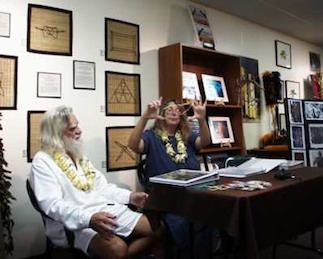
String
Figures were used to teach about the traditions and practices of the
culture in which they were made. Storytellers from cultures around the
world teach lessons through their stories of Gods, Spirits, People and
Places. Animals and all of nature are portrayed in their tales. In oral
traditions it was the storyteller who remembered and taught the beliefs
of the people. It was through dance and music that the connection
between God, Nature and Man was strengthened. String figures and their
chants were used to tell stories in Hawaii. Even today we do "talk
story" as a form of communication and connection with others.
String Figures are a game. Play and games have an important part
in the culture of today and they played an important role in the
cultures of the days of old. String is an ancient tool and the concept
of string figures going back to the stone and bronze ages is not hard to
believe.
In the book Secret Games of the Gods By Nigel Pennick (1989),
Games had influences, beyond simple play into the ancient ritual systems
of the culture. We have explored the use of string figures as a tool
for divination. For those that are interested, we have found that a
piece of string can be used as a radionic device. Again please contact
us if you want to learn more.
Abraham (1928: 86-89) talks about string figure’s use in games
and competition. One had to have great pride in making a complex string
figure quickly. In Hawai’i it was reported that string figures were made
during the Makahiki season where work and war were put to rest and the
time for relaxation and celebration had arrived.
The Navaho used string figures to teach about the stars
(Sherman ISFA Bulletin 7: 197-207). Many string figures in Hawaii
are made relating to the sun, moon, stars and in particular the
Pleiades. Navigators played an important role in the use and spread of
string figures throughout the world.
Knotted strings were used in Peru, the Marquesas and in Hawaii.
The knots were used as mnemonic devices to help those of an oral
tradition to remember and to record. We have been told that knotted
strings were used to help a chanter remember the chants of the
genealogies that he recited. We have seen their use in ritual.
Today, because this is a living tradition, we feel that string
figures have a place in the education of every child. First, taught from
family and friends to strengthen the communication and connecting bonds
which are so important in our lives. Then, as an essential element in
formal education. If string figures were used as a teaching method,
teachers would see how their educational goals and objectives could be
met. Children with all levels of abilities could benefit from the
development of memory, attention, motor development and coordination
skills. The development of confidence, perseverance and problem solving
skills among others can also be facilitated though string figures. There
is value in the integration of string figures into the social studies,
language arts, science and mathematics curriculum. But we need not stop
there. They have a valued use by Counselors, Health Practitioners,
Physical Education Teachers, Special Education Teachers, Speech-Language
Pathologists, Physical and Occupational Therapists, Learning
Disabilities Specialists and the many, many others that work with
children in our schools, hospitals and clinics.
Please contact Lois if you are interested in knowing more about
the use of string figures as a teaching tool. She holds a Masters degree
in Speech-Language Pathology and has a strong belief that a simple loop
of string is an inexpensive diagnostic and teaching tool.